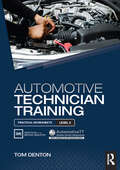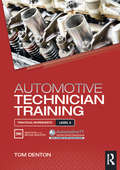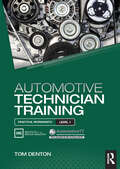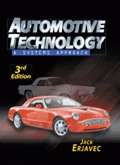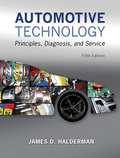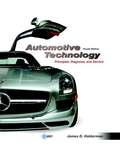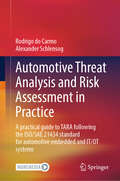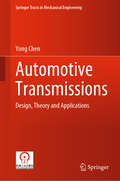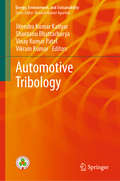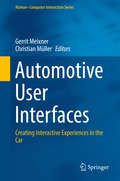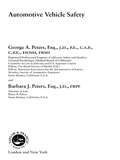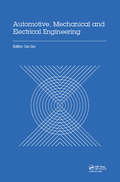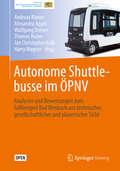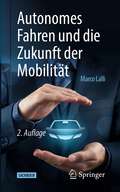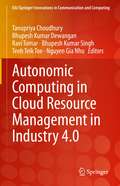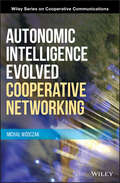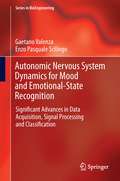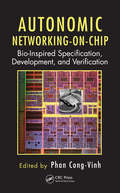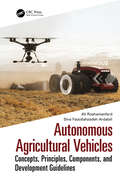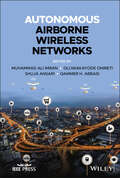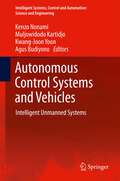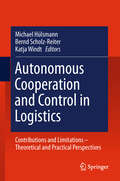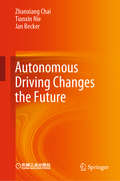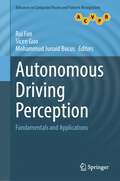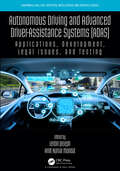- Table View
- List View
Automotive Technician Training: Practical Worksheets
by Tom DentonAutomotive practical worksheets and assessments for students at Level 2 This Level 2 Student Worksheets book contains tasks that help you develop practical skills and prepare you for assessment. The tasks also reinforce the automotive theory that you will learn online and in the classroom. Each worksheet covers individual topics in a step-by-step manner, detailing how to carry out all of the most important tasks contained within the syllabus. Alongside each of these worksheets is a job card that can be filled in and used as evidence towards your qualification. Endorsed by the Institute of the Motor Industry for all of their Level 2 automotive courses. Step-by-step guides to the practical tasks required at all Level 2 qualifications. Job sheets for students to complete and feedback sheets for assessors to complete.
Automotive Technician Training: Practical Worksheets
by Tom DentonAutomotive practical worksheets and assessments for students at Level 3 This Level 3 Student Worksheets book contains tasks that help you develop practical skills and prepare you for assessment. The tasks also reinforce the automotive theory that you will learn online and in the classroom. Each worksheet covers individual topics in a step-by-step manner, detailing how to carry out all of the most important tasks contained within the syllabus. Alongside each of these worksheets is a job card that can be filled in and used as evidence towards your qualification. Endorsed by the Institute of the Motor Industry for all of their Level 3 automotive courses. Step-by-step guides to the practical tasks required at all Level 3 qualifications. Job sheets for students to complete and feedback sheets for assessors to complete.
Automotive Technician Training: Practical Worksheets
by Tom DentonAutomotive practical worksheets and assessments for students at Level 1 This Level 1 Student Worksheets book contains tasks that help you develop practical skills and prepare you for assessment. The tasks also reinforce the automotive theory that you will learn online and in the classroom. Each worksheet covers individual topics in a step-by-step manner, detailing how to carry out all of the most important tasks contained within the syllabus. Alongside each of these worksheets is a job card that can be filled in and used as evidence towards your qualification. Endorsed by the Institute of the Motor Industry for all of their Level 1 automotive courses. Step-by-step guides to the practical tasks required at all Level 1 qualifications. Job sheets for students to complete and feedback sheets for assessors to complete.
Automotive Technology: A Systems Approach, 3rd Edition
by Jack ErjavecThis comprehensive textbook covers the theory of operation, diagnostics, and repair procedures for each system and subsystem of late model domestic and imported automobiles and light trucks. The new edition is published in full color for the first time, including all new step-by-step photo sequences to help users visualize and identify common repair procedures. The technical content has been both updated and improved. An emphasis is placed upon providing the best possible coverage of key topics virtually all automotive technicians must know electricity-electronics, engine performance, steering and suspension and brakes. "Hot Topics" such as the use of diagnostic equipment (including lab scopes), hazardous materials management, OBDII, electronic automatic transmissions, anti-lock braking systems, air-conditioning refrigerants and retrofitting, passive restraint systems and many others have been expanded and updated. Key new teaching tools, including 100 full-color transparency acetates, and Power- Point based lecture outlines, have been added to make the teaching package the best available.
Automotive Technology: Principles, Diagnosis, and Service
by James D. HaldermanAutomotive Technology: Principles, Diagnosis, and Service,Fifth Edition covers all eight areas of automotive service, showing readers how automotive systems are connected, as well as the practical skills that students must master to be successful in the industry. Topics are divided into short chapters, which makes it easier to assign, learn, and master the content. Formatted to appeal to today's technical trade students, Halderman uses helpful tips and visuals to bring concepts to life and guide students through the procedures they'll use on the job. To keep your course current, all of the content is correlated to the latest NATEF tasks and ASE areas, and information on hot topics like electric and hybrid vehicles is included.
Automotive Technology: Principles, Diagnosis, and Service (Fourth Edition)
by James D. HaldermanThis comprehensive textbook is divided into sections that correspond to the eight areas of certifications as specified by the National Institute for Automotive Service Excellence (ASE) and the National Automotive Technicians Education Foundation (NATEF). The areas of the ASE material certification test are listed in the objectives at the beginning of each chapter, and all laboratory worksheets are correlated to the NATEF Task List.
Automotive Threat Analysis and Risk Assessment in Practice: A practical guide to TARA following the ISO/SAE 21434 standard for automotive embedded and IT/OT systems
by Rodrigo do Carmo Alexander SchlensogThe surge in automotive cybersecurity regulations necessitates a structured risk management method. This work examines these regulations, details the European cybersecurity legal framework, and explores the ISO/SAE 21434's threat analysis and risk assessment (TARA) approach. Implementing TARA in real-world scenarios presents challenges, such as identifying the correct assets or performing accurate threat modeling. This book employs a pragmatic approach to TARA across three domains: electrical and electronic systems within the vehicle, the vehicle's connected ecosystem, and manufacturing plants, integrating insights from ISO/IEC 27000 and IEC 62443 standard series without seeking to harmonize them. This book offers a technical guideline for TARA, presenting detailed case studies across these domains and emphasizing technical rigor while ensuring efficiency.
Automotive Transmissions: Design, Theory and Applications (Springer Tracts in Mechanical Engineering)
by Yong ChenThis book introduces readers to the theory, design and applications of automotive transmissions. It covers multiple categories, e.g. AT, AMT, CVT, DCT and transmissions for electric vehicles, each of which has its own configuration and characteristics. In turn, the book addresses the effective design of transmission gear ratios, structures and control strategies, and other topics that will be of particular interest to graduate students, researchers and engineers. Moreover, it includes real-world solutions, simulation methods and testing procedures. Based on the author’s extensive first-hand experience in the field, the book allows readers to gain a deeper understanding of vehicle transmissions.
Automotive Tribology (Energy, Environment, and Sustainability)
by Shantanu Bhattacharya Jitendra Kumar Katiyar Vinay Kumar Patel Vikram KumarThis book presents a comprehensive study of all important aspects of tribology. It covers issues and their remedies adopted by researchers working on automobile systems. The book is broadly divided in to three sections, viz. (i) new materials for automotive applications, (ii) new lubricants for automotive applications, and (iii) impact of surface morphologies for automotive applications. The rationale for this division is to provide a comprehensive and categorical review of the developments in automotive tribology. The book covers tribological aspects of engines, and also discusses influence of new materials, such as natural fibers, metal foam materials, natural fiber reinforced polymer composites, carbon fiber/silicon nitride polymer composites and aluminium matrix composites. The book also looks at grease lubrication, effectiveness and sustainability of solid/liquid additives in lubrication, and usage of biolubricants. In the last section the book focuses on brake pad materials, shot peening method, surface texturing, magnetic rheological fluid for smart automobile brake and clutch systems, and application of tribology in automobile systems. This book will be of interest to students, researchers, and professionals from the automotive industry.
Automotive User Interfaces: Creating Interactive Experiences in the Car (Human–Computer Interaction Series)
by Christian Müller Gerrit MeixnerThis book focuses on automotive user interfaces for in-vehicle usage, looking at car electronics and its software of hidden technologies (e. g. , ASP, ESP), comfort functions (e. g. , navigation, communication, entertainment) and driver assistance (e. g. , distance checking). The increased complexity of automotive user interfaces, driven by the need for using consumer electronic devices in cars as well as autonomous driving, has sparked a plethora of new research within this field of study. Covering a broad spectrum of detailed topics, the authors of this edited volume offers an outstanding overview of the current state of the art; providing deep insights into usability and user experience, interaction techniques and technologies as well as methods, tools and its applications; exploring the increasing importance of Human-Computer-Interaction (HCI) within the automotive industry. Automotive User Interfaces is intended as an authoritative and valuable resource for professional practitioners and researchers alike, as well as computer science and engineering students who are interested in automotive interfaces.
Automotive Vehicle Safety
by George A. Peters Barbara J. PetersAutomotive Vehicle Safety is a unique academic text, practical design guide and valuable reference book. It provides information that is essential for specialists to make better-informed decisions. The book identifies and discusses key generic safety principles and their applications and includes decision-making criteria, examples and remedies. It
Automotive, Mechanical and Electrical Engineering: Proceedings of the 2016 International Conference on Automotive Engineering, Mechanical and Electrical Engineering (AEMEE 2016), Hong Kong, China, December 9-11, 2016
by Lin LiuThe 2016 International Conference on Automotive Engineering, Mechanical and Electrical Engineering (AEMEE 2016) was held December 9-11, 2016 in Hong Kong, China. AEMEE 2016 was a platform for presenting excellent results and new challenges facing the fields of automotive, mechanical and electrical engineering. Automotive, Mechanical and Electrical Engineering brings together a wide range of contributions from industry and governmental experts and academics, experienced in engineering, design and research. Papers have been categorized under the following headings: Automotive Engineering and Rail Transit Engineering. Mechanical, Manufacturing, Process Engineering. Network, Communications and Applied Information Technologies. Technologies in Energy and Power, Cell, Engines, Generators, Electric Vehicles. System Test and Diagnosis, Monitoring and Identification, Video and Image Processing. Applied and Computational Mathematics, Methods, Algorithms and Optimization. Technologies in Electrical and Electronic, Control and Automation. Industrial Production, Manufacturing, Management and Logistics.
Autonome Shuttlebusse im ÖPNV: Analysen und Bewertungen zum Fallbeispiel Bad Birnbach aus technischer, gesellschaftlicher und planerischer Sicht
by Thomas Huber Harry Wagner Wolfgang Dorner Andreas Riener Alexandra Appel Jan Christopher KolbAutomatisiertes Fahren wird aktuell auf allen Ebenen diskutiert. Dieses Open Access Buch greift das Thema aus Sicht des ÖPNV auf und stellt Chancen und Risiken des Einsatzes automatisierter Shuttlebusse im Nahverkehr dar. Am Beispiel Bad Birnbach/Niederbayern wird gezeigt, welche Herausforderungen bei der Einführung eines solchen Services zu erwarten sind und wie diese gelöst werden können. Dabei fokussiert sich das Buch auf die Vermittlung von im Feld erhobenen Daten, z.B. zu technischen Schwierigkeiten, Erfahrungsberichten von Anwohnern und Gästen, Akzeptanz in der Bevölkerung, infrastrukturellen Anforderungen, etc. Konkrete Handlungsempfehlungen für Städteplaner, ÖPNV-Betreiber/-Strategen oder Kommunen, die eine Einführung automatisierter Busse in Erwägung ziehen, runden das Werk ab.
Autonomes Fahren und die Zukunft der Mobilität
by Marco LalliAutos werden sich in wenigen Jahren selbst steuern, darüber sind sich alle einig. Fahrzeughersteller und Zulieferer forschen weltweit intensiv daran, und auch die großen IT-Multis wie Google und Apple sehen das als Chance, ihre angestammten Märkte zu erweitern. Doch was bedeutet diese bevorstehende Revolution für die Verkehrsträger der Zukunft, für die vielen davon betroffenen Branchen, für unsere Städte, für die Art und Weise, wie wir leben und arbeiten werden?Der Umwelt- und Sozialpsychologe Marco Lalli hat die aktuellen technischen Umwälzungen zum Anlass genommen, deren Konsequenzen für unser Zusammenleben weiter zu denken. Das selbstfahrende Automobil wird nicht nur den Fahrer zuerst entlasten und dann überflüssig machen, es wird neue Geschäftsmodelle hervorbringen und bislang bewährte verschwinden lassen, es wird bestimmte Verkehrsträger zur Bedeutungslosigkeit verdammen und nicht zuletzt das Gesicht unserer Städte radikal verändern. In seinem spannenden Aufsatz beschreibt Marco Lalli eine nicht mehr allzu ferne Zukunft und mahnt die Verantwortlichen in Politik und Wirtschaft, sich darauf einzustellen.
Autonomic Computing in Cloud Resource Management in Industry 4.0 (EAI/Springer Innovations in Communication and Computing)
by Nguyen Gia Nhu Tanupriya Choudhury Ravi Tomar Teoh Teik Toe Bhupesh Kumar Dewangan Bhupesh Kumar SinghThis book describes the next generation of industry—Industry 4.0—and how it holds the promise of increased flexibility in manufacturing, along with automation, better quality, and improved productivity. The authors discuss how it thus enables companies to cope with the challenges of producing increasingly individualized products with a short lead-time to market and higher quality. The authors posit that intelligent cloud services and resource sharing play an important role in Industry 4.0 anticipated Fourth Industrial Revolution. This book serves the different issues and challenges in cloud resource management CRM techniques with proper propped solution for IT organizations. The book features chapters based on the characteristics of autonomic computing with its applicability in CRM. Each chapter features the techniques and analysis of each mechanism to make better resource management in cloud.
Autonomic Intelligence Evolved Cooperative Networking (Wiley Series on Cooperative Communications)
by Michal WodczakAutonomic Intelligence Evolved Cooperative Networking offers a comprehensive advancement of the state-of-the art technological developments in the fields of Cooperative Networking and Autonomic Computing. Based on his track record in industrial standardisation, as well as academic and applied research, the author presents a fully-fledged Autonomic Cooperative Networking Architectural Model that encompasses the relevant workings of both the Layers of the Open Systems Interconnection Reference Model and the Levels of the Generic Autonomic Network Architecture. .
Autonomic Nervous System Dynamics for Mood and Emotional-State Recognition: Significant Advances in Data Acquisition, Signal Processing and Classification (Series in BioEngineering)
by Gaetano Valenza Enzo Pasquale ScilingoThis monograph reports on advances in the measurement and study of autonomic nervous system (ANS) dynamics as a source of reliable and effective markers for mood state recognition and assessment of emotional responses. Its primary impact will be in affective computing and the application of emotion-recognition systems. Applicative studies of biosignals such as: electrocardiograms; electrodermal responses; respiration activity; gaze points; and pupil-size variation are covered in detail, and experimental results explain how to characterize the elicited affective levels and mood states pragmatically and accurately using the information thus extracted from the ANS. Nonlinear signal processing techniques play a crucial role in understanding the ANS physiology underlying superficially noticeable changes and provide important quantifiers of cardiovascular control dynamics. These have prognostic value in both healthy subjects and patients with mood disorders. Moreover, Autonomic Nervous System Dynamics for Mood and Emotional-State Recognition proposes a novel probabilistic approach based on the point-process theory in order to model and characterize the instantaneous ANS nonlinear dynamics providing a foundation from which machine "understanding" of emotional response can be enhanced. Using mathematics and signal processing, this work also contributes to pragmatic issues such as emotional and mood-state modeling, elicitation, and non-invasive ANS monitoring. Throughout the text a critical review on the current state-of-the-art is reported, leading to the description of dedicated experimental protocols, novel and reliable mood models, and novel wearable systems able to perform ANS monitoring in a naturalistic environment. Biomedical engineers will find this book of interest, especially those concerned with nonlinear analysis, as will researchers and industrial technicians developing wearable systems and sensors for ANS monitoring.
Autonomic Networking-on-Chip: Bio-Inspired Specification, Development, and Verification (Embedded Multi-Core Systems)
by Phan Cong-VinhDespite the growing mainstream importance and unique advantages of autonomic networking-on-chip (ANoC) technology, Autonomic Networking-On-Chip: Bio-Inspired Specification, Development, and Verification is among the first books to evaluate research results on formalizing this emerging NoC paradigm, which was inspired by the human nervous system. The FIRST Book to Assess Research Results, Opportunities, & Trends in "BioChipNets" The third book in the Embedded Multi-Core Systems series from CRC Press, this is an advanced technical guide and reference composed of contributions from prominent researchers in industry and academia around the world. A response to the critical need for a global information exchange and dialogue, it is written for engineers, scientists, practitioners, and other researchers who have a basic understanding of NoC and are now ready to learn how to specify, develop, and verify ANoC using rigorous approaches. Offers Expert Insights Into Technical Topics Including: Bio-inspired NoC How to map applications onto ANoC ANoC for FPGAs and structured ASICs Methods to apply formal methods in ANoC development Ways to formalize languages that enable ANoC Methods to validate and verify techniques for ANoC Use of "self-" processes in ANoC (self-organization, configuration, healing, optimization, protection, etc.) Use of calculi for reasoning about context awareness and programming models in ANoC With illustrative figures to simplify contents and enhance understanding, this resource contains original, peer-reviewed chapters reporting on new developments and opportunities, emerging trends, and open research problems of interest to both the autonomic computing and network-on-chip communities. Coverage includes state-of-the-art ANoC architectures, protocols, technologies, and applications. This volume thoroughly explores the theory behind ANoC to illustrate strategies that enable readers to use formal ANoC methods yet still make sound judgments and allow for reasonable justifications in practice.
Autonomous Agricultural Vehicles: Concepts, Principles, Components, and Development Guidelines
by Ali Roshanianfard Sina Faizollahzadeh ArdabiliThis comprehensive guide to agricultural robots is the ideal companion for any student or professional engineer looking to understand and develop autonomous vehicles to use on the modern farm. With world hunger one of the modern era’s most pressing issues, autonomous agricultural vehicles are a key tool in tackling this problem. Smart farming can increase total factory productivity through designing autonomous vehicles based on specific needs, in addition to implementing smart systems into day-to-day operations. This book provides step-by-step guidance, from the theory behind autonomous vehicles, through to the design process and manufacture. Detailing all components of an autonomous agricultural vehicle, from sensors, controlling algorithms, communication and controlling units, the book covers topics such as artificial intelligence and machine learning. It also includes case studies, and a detailed guide to international policymaking in recent years. Suitable for students and professionals alike, this book will be a key companion to those interested in agricultural engineering, autonomous vehicles, robotics, and mechatronics, in mechanical, automotive, and electrical engineering.
Autonomous Airborne Wireless Networks (Wiley - IEEE)
by Muhammad Ali ImranDiscover what lies beyond the bleeding-edge of autonomous airborne networks with this authoritative new resource Autonomous Airborne Wireless Networks delivers an insightful exploration of recent advances in the theory and practice of using airborne wireless networks to provide emergency communications, coverage and capacity expansion, information dissemination, and more. The distinguished engineers and editors have selected resources that cover the fundamentals of airborne networks, including channel models, recent regulation developments, self-organized networking, AI-enabled flying networks, and notable applications in a variety of industries. The book evaluates advances in the cutting-edge of unmanned aerial vehicle wireless network technology while offering readers new ideas on how airborne wireless networks can support various applications expected of future networks. The rapidly developing field is examined from a fresh perspective, one not just concerned with ideas of control, trajectory optimization, and navigation. Autonomous Airborne Wireless Networks considers several potential use cases for the technology and demonstrates how it can be integrated with concepts from self-organized network technology and artificial intelligence to deliver results in those cases. Readers will also enjoy: A thorough discussion of distributed drone base station positioning for emergency cellular networks using reinforcement learning (AI-enabled trajectory optimization) An exploration of unmanned aerial vehicle-to-wearables (UAV2W) indoor radio propagation channel measurements and modelling An up-to-date treatment of energy minimization in UAV trajectory design for delay tolerant emergency communication Examinations of cache-enabled UAVs, 3D MIMO for airborne networks, and airborne networks for Internet of Things communications Perfect for telecom engineers and industry professionals working on identifying practical and efficient concepts tailored to overcome challenges facing unmanned aerial vehicles providing wireless communications, Autonomous Airborne Wireless Networks also has a place on the bookshelves of stakeholders, regulators, and research agencies working on the latest developments in UAV communications.
Autonomous Control Systems and Vehicles: Intelligent Unmanned Systems (Intelligent Systems, Control and Automation: Science and Engineering #65)
by Kenzo Nonami Agus Budiyono Kwang-Joon Yoon Muljowidodo KartidjoThe International Conference on Intelligent Unmanned Systems 2011 was organized by the International Society of Intelligent Unmanned Systems and locally by the Center for Bio-Micro Robotics Research at Chiba University, Japan. The event was the 7th conference continuing from previous conferences held in Seoul, Korea (2005, 2006), Bali, Indonesia (2007), Nanjing, China (2008), Jeju, Korea (2009), and Bali, Indonesia (2010). ICIUS 2011 focused on both theory and application, primarily covering the topics of robotics, autonomous vehicles, intelligent unmanned technologies, and biomimetics. We invited seven keynote speakers who dealt with related state-of-the-art technologies including unmanned aerial vehicles (UAVs) and micro air vehicles (MAVs), flapping wings (FWs), unmanned ground vehicles (UGVs), underwater vehicles (UVs), bio-inspired robotics, advanced control, and intelligent systems, among others. This book is a collection of excellent papers that were updated after presentation at ICIUS2011. All papers that form the chapters of this book were reviewed and revised from the perspective of advanced relevant technologies in the field. The aim of this book is to stimulate interactions among researchers active in the areas pertinent to intelligent unmanned systems.
Autonomous Cooperation and Control in Logistics: Contributions and Limitations - Theoretical and Practical Perspectives
by Michael Hülsmann Bernd Scholz-Reiter Katja WindtMany new technologies - like RFID, GPS, and sensor networks - that dominate innovative developments in logistics are based on the idea of autonomous cooperation and control. This self-organisational concept describes "...processes of decentralized decision-making in heterarchical structures. It presumes interacting elements in non-deterministic systems, which possess the capability and possibility to render decisions. The objective of autonomous cooperation and control is the achievement of increased robustness and positive emergence of the total system due to distributed and flexible coping with dynamics and complexity" (Hülsmann & Windt, 2007). In order to underlie these technology-driven developments with a fundamental theoretical foundation this edited volume asks for contributions and limitations of applying the principles of autonomous cooperation and control to logistics processes and systems. It intends to identify, describe, and explain - in the context of production and distribution logistics - the effects on performance and robustness, the enablers and impediments for the feasibility, the essential cause-effect-relations, etc. of concepts, methods, technologies, and routines of autonomous cooperation and control in logistics. Therefore, the analyses collected in this edited volume aim to develop a framework for finding the optimal degree as well as the upper and lower boundaries of autonomous cooperation and control of logistics processes from the different perspectives of production technology, electronics and communication engineering, informatics and mathematics, as well as management sciences and economics.
Autonomous Driving Changes the Future
by Jan Becker Zhanxiang Chai Tianxin NieThis book systematically discusses the development of autonomous driving, describing the related history, technological advances, infrastructure, social impacts, international competition, China’s opportunities and challenges, and possible future scenarios. This popular science book uses straightforward language and includes quotes from ancient Chinese poems to enhance the reading experience. The discussions are supplemented by theoretical elaborations, presented in tables and figures.The book is intended for auto fans, upper undergraduate and graduate students in the field of automotive engineering.
Autonomous Driving Perception: Fundamentals and Applications (Advances in Computer Vision and Pattern Recognition)
by Rui Fan Sicen Guo Mohammud Junaid BocusDiscover the captivating world of computer vision and deep learning for autonomous driving with our comprehensive and in-depth guide. Immerse yourself in an in-depth exploration of cutting-edge topics, carefully crafted to engage tertiary students and ignite the curiosity of researchers and professionals in the field. From fundamental principles to practical applications, this comprehensive guide offers a gentle introduction, expert evaluations of state-of-the-art methods, and inspiring research directions. With a broad range of topics covered, it is also an invaluable resource for university programs offering computer vision and deep learning courses. This book provides clear and simplified algorithm descriptions, making it easy for beginners to understand the complex concepts. We also include carefully selected problems and examples to help reinforce your learning. Don't miss out on this essential guide to computer vision and deep learning for autonomous driving.
Autonomous Driving and Advanced Driver-Assistance Systems: Applications, Development, Legal Issues, and Testing (Chapman & Hall/CRC Artificial Intelligence and Robotics Series)
by Lentin JosephAutonomous Driving and Advanced Driver-Assistance Systems (ADAS): Applications, Development, Legal Issues, and Testing outlines the latest research related to autonomous cars and advanced driver-assistance systems, including the development, testing, and verification for real-time situations of sensor fusion, sensor placement, control algorithms, and computer vision. Features: Co-edited by an experienced roboticist and author and an experienced academic Addresses the legal aspect of autonomous driving and ADAS Presents the application of ADAS in autonomous vehicle parking systems With an infinite number of real-time possibilities that need to be addressed, the methods and the examples included in this book are a valuable source of information for academic and industrial researchers, automotive companies, and suppliers.
